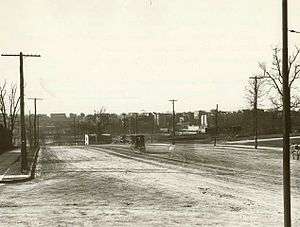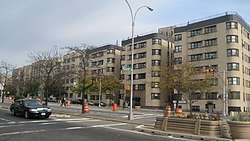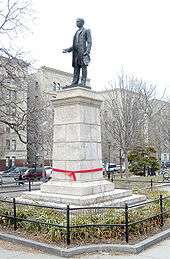Grand Concourse (Bronx)
 Intersection with 161st Street in 1900 | |
| Owner | City of New York |
|---|---|
| Maintained by | NYCDOT |
| Length | 5.2 mi[1] (8.4 km) |
| Location | Bronx, New York City |
| South end |
|
| North end |
|
| Construction | |
| Construction start | 1894 |
| Completion | 1909 |
| Other | |
| Designer | Louis Aloys Risse |
|
Grand Concourse Historic District | |
 Art Deco apartment buildings along Grand Concourse. | |
 | |
| Location | The Bronx, New York |
|---|---|
| Coordinates | 40°49′50″N 73°55′15″W / 40.83056°N 73.92083°WCoordinates: 40°49′50″N 73°55′15″W / 40.83056°N 73.92083°W |
| Architect | Multiple |
| Architectural style | Late 19th And 20th Century Revivals, Art Deco, Other |
| NRHP reference # | 87001388[2] |
| Added to NRHP | August 24, 1987 |
The Grand Concourse (originally known as the Grand Boulevard and Concourse) is a major thoroughfare in the borough of the Bronx in New York City. It was designed by Louis Aloys Risse, an immigrant from Saint-Avold, Lorraine who had previously worked for the New York Central Railroad and was later appointed chief topographical engineer for the New York City government.
Some of the neighborhoods that Grand Concourse runs through include Claremont, Concourse, Highbridge, Fordham, Mott Haven, Mount Eden, Mount Hope, and Tremont.[3]
History
_(14765078865).jpg)
Risse first conceived of the road in 1890, as a means of connecting the borough of Manhattan to the northern Bronx.[4] Construction began on the Grand Concourse in 1894 and it was opened to traffic in November 1909. Built during the height of the City Beautiful movement, it was modeled on the Champs-Élysées in Paris but is considerably larger, stretching four miles (6 km) in length, measuring 180 feet (55 m) across, and separated into three roadways by tree-lined dividers, so some minor streets did not cross the Concourse. The cost of the project was $14 million (worth $411,824,000 today).[5] The road originally stretched from Bronx Borough Hall at 161st Street north to Van Cortlandt Park, although it was expanded southward to 138th street in 1927 after Mott Avenue was widened to accommodate the boulevard.[6]
The IRT Jerome Avenue Line of the New York City Subway opened a few blocks west of the Grand Concourse in 1917, initiating a housing boom amongst upwardly mobile, predominantly Jewish and Italian, families who were fleeing the crowded tenements of Manhattan. In 1923, Yankee Stadium opened near the Grand Concourse at 161st Street, down the hill from the Concourse Plaza Hotel. South of Fordham Road, the palatial Loew's Paradise theater, one of the Loew's Wonder Theatres and at one time the largest movie theater in New York City, was constructed in 1929.[7]
Development of the Concourse was further encouraged by the opening of the IND Concourse Line in 1933. By the mid-1930s, almost three hundred apartment buildings had been built along the Concourse. Customarily five or six stories high with wide entrance courtyards bordered with grass and shrubs, among these apartments are many of the finest examples of Art Deco and Art Moderne architecture in the United States. Even though the Great Depression, which was happening at the time, ended the period of tremendous growth, privately financed apartment buildings continued to be constructed. Furthermore, work was done on the Grand Concourse as part of WPA programs.[3] During this period, the Bronx had more amenities than other boroughs: in 1934, almost 99% of residences had private bathrooms, and 95% had central heating.[8] In the 1939 WPA guide to New York, the Grand Concourse was described as "the Park Avenue of middle-class Bronx residents, and the lease to an apartment in one of its many large buildings is considered evidence of at least moderate business success."[9]
In 1941, the New York City Planning Department proposed converting the boulevard into an expressway, in order to connect the Major Deegan Expressway and the proposed Park Avenue Expressway to the south with the Mosholu Parkway to the north. However, these plans were abandoned following the southern extension of the Bronx River Parkway in the 1940s and the extension of the Major Deegan Expressway to the north in the 1950s.[10]
The south and central Bronx began to rapidly deteriorate in the 1960s. White flight drained many residents of the South Bronx, pulled by the dream of suburban life and pushed by fear of mounting crime. At the same time, over 170,000 people displaced by slum clearance in Manhattan, mostly African American and Puerto Rican, moved to the Bronx. The city also adopted policies of relocating welfare recipients to the area, paying fees to landlords. Migration to the suburbs, retirement to Florida, and the construction of Co-op City in the fringes of the northeastern Bronx between 1968 and 1970 drained the areas along the Grand Concourse of most of its remaining middle-class residents. Many if not most buildings in the area were damaged by arson, vandalism, and a lack of maintenance. Even along the Grand Concourse, some buildings and apartments were left abandoned and boarded or bricked shut. Starting in the 1990s, when the Bronx's population began to grow for the first time in twenty years, a wave of affordable housing construction came to the area.
In 1992, the New York City Department of Transportation conducted a study of the Grand Concourse, which resulted in improvements such as left-turn signals; pedestrian barriers; roadway markings; repainted crosswalks; and new and improved signage. These improvements continued along the entire corridor through 2006.[11]:16–19 As an experiment, the NYCDOT also completely rebuilt the section between 161st Street and 167th Streets starting in 1999, as a "demonstration" project.[11]:20–26 The Grand Concourse underwent an $18 million restoration and landscaping to widen and landscape the medians; improve lighting; add new signage; and build pedestrian planters in the medians. This resulted in a 69% drop in accidents along this section between 1998 and 2005.[11]:20–22 The final part of the demonstration project was completed in 2008.[12] Later, this was expanded to a four-phase capital project between 161st Street and Fordham Road as part of a Capital Project, which would receive funding directly from the city. A reconstruction of the Grand Concourse between 166th and 171st Street began in 2013[13] and is expected to be finished in June 2017.[14] Funding is being allocated for a reconstruction of the Grand Concourse from 171st Street to 175th Street, which is already in planning.[15] In January 2017, the New York City Department of Transportation started planning for a fourth phase, which will renovate the section between 175th Street and Fordham Road.[14]
In 2011, the New York City Landmarks Preservation Commission declared a historic district on the Grand Concourse from 153rd to 167th Street.[16][17] The State of New York had previously nominated for listing the buildings at 730–1000, 1100–1520, 1560, and 851–1675 Grand Concourse for listing on the National Register of Historic Places as a historic district[2][18] and several New York City Landmarks are on the Concourse.[19]
Because of its attractive art deco buildings and close proximity to Manhattan, the southern portion has been experiencing gentrification and is drawing many young professionals to the area.[20] In fact, in recent years the area around the Grand Concourse has been the center of what real state agents are calling a “renewal.” New people are moving in and severe crime rates have significantly gone down. However, opinions are still divided, as some think that, while the area will experience demographic changes, it will be working-class, “community-oriented” people, as opposed to richer individuals, like in other neighborhoods of the city.[21]
Significant buildings
Several buildings of importance to New York City and the Bronx, both because of their history and their current use, are located along the Grand Concourse.[3] Among these stand out:
- The Bronx County Courthouse
- The Bronx General Post Office
- The Bronx Museum of the Arts
- Dollar Savings Bank Building, the 10-story headquarters of the Dollar Dry Dock Savings Banks (now liquidated)
- Hostos Community College, at 475 Grand Concourse
- Loew's Paradise Theater, in Fordham
- The Poe Cottage, the last home of Edgar Allan Poe
- The Fish Building, at 1150 Grand Concourse[16]
In popular culture

- Novelist E. L. Doctorow has featured the Grand Concourse in much of his writing.
- In Jacob M. Appel's story, "The Grand Concourse" (2007),[23] a woman who grew up in the Lewis Morris Building returns to the Morrisania neighborhood with her adult daughter to discover the boulevard is far from how she remembers it.
- The Grand Concourse figures prominently in Tom Wolfe's 1987 novel The Bonfire of the Vanities, where its evolution from "the summit of the Jewish dream" and the "new Canaan" to a rundown, unsafe thoroughfare is seen through the eyes of frustrated Assistant District Attorney Larry Kramer.
- In the television series Rhoda, Rhoda Morgenstern's parents Ida and Martin live in an apartment on the Grand Concourse.
- Grand Concourse "Avenue" is referred to in Act One, Scene One, of Tony Kushner's 1993 play Angels in America: A Gay Fantasia on National Themes, where Rabbi Isidor Chemelwitz describes it as a first generation immigrant settlement.
- Ayn Rand mentions the Grand Concourse in The Fountainhead, when Dominique decides to have a justice of the peace in Connecticut marry her to Peter Keating. To speed the trip, Keating tells her to "get to the Grand Concourse. Fewer lights there."
- In The Facts of Life episode "Taking a Chance On Love", Jo and her photography professor discuss art. She mentions the Grand Concourse as a place that creates a feeling within her.
See also
- Edgar Allan Poe Cottage
- Transport on the boulevard:
- IND Concourse Line – runs under the boulevard north of East 161st Street
- IRT Jerome Avenue Line – runs under the boulevard south of East 149th Street
- Grand Concourse buses, especially Bx1 and Bx2
- 1100 Grand Concourse
- Paradise Theater
References
- ↑ Google (July 3, 2018). "Grand Concourse" (Map). Google Maps. Google. Retrieved July 3, 2018.
- 1 2 National Park Service (2008-04-15). "National Register Information System". National Register of Historic Places. National Park Service.
- 1 2 3 Jackson, Kenneth T., ed. (2010), The Encyclopedia of New York City (2nd ed.), New Haven: Yale University Press, ISBN 978-0-300-11465-2
- ↑ The New York Times, March 18, 2009 Looking back at the Grand Concourse First Century
- ↑ "The Inflation Calculator". Archived from the original on 21 July 2007. Retrieved 13 April 2016.
- ↑ "BACK ON 'COURSE: Revisiting the Grand Concourse". Retrieved 13 April 2016.
- ↑ "Fire Badly Damages Paradise Theater, a Bronx Landmark". The New York Times. Retrieved 25 November 2015.
- ↑ "ONE HUNDRED YEARS OF THE BRONX". Archived from the original on 21 October 2007. Retrieved 11 October 2015.
- ↑ "Takin' the Bronx by 'Course – Forgotten NY". Archived from the original on October 12, 2010. Retrieved 11 October 2015.
- ↑ "Grand Concourse Express Highway (NY 22 and NY 100, unbuilt)". Retrieved 13 April 2016.
- 1 2 3 "SAFE STREETS NYC: The Bronx" (PDF). nyc.gov. New York City Department of Transportation. June 2007. pp. 16–30. Retrieved 2017-03-12.
- ↑ "Grand Concourse 2008" (PDF). New York City Department of Transportation. Retrieved 2016-12-27.
- ↑ "HWXP136A RECONSTRUCTION OF GRAND CONCOURSE SERVICE ROADS EAST 166TH STREET TO EAST 171ST STREET" (PDF). nyc.gov. New York City Department of Transportation. February 2013. Retrieved 2016-12-27.
- 1 2 "GRAND CONCOURSE PHASE 4 Community Workshop" (PDF). nyc.gov. New York City Department of Transportation. January 19, 2017. Retrieved 2017-03-06.
- ↑ "GRAND CONCOURSE PHASE 3". Scribd. New York City Department of Transportation. June 1, 2016. Retrieved 2016-12-27.
- 1 2 Dolnick, Sam (22 June 2010). "As Concourse Regains Luster, City Notices". The New York Times. Retrieved 19 March 2011.
- ↑ Grand Concourse Gets Its Due by Patrick Wall, October 25, 2011, The New York Times
- ↑ "Grand, Wasn't It?" by Constance Rosenblum, The New York Times, August 21, 2009
- ↑ "Cultural Resource Information System (CRIS)". New York State Office of Parks, Recreation and Historic Preservation. Archived from the original (Searchable database) on 2015-07-01. Retrieved 2016-03-01. Note: This includes Merrill Hesch (May 1987). "National Register of Historic Places Registration Form: Grand Concourse Historic District" (PDF). Retrieved 2016-03-01. and Accompanying 14 photographs
- ↑ Berger, Joseph. "No Longer Burning, the South Bronx Gentrifies". The New York Times. Retrieved 25 November 2015.
- ↑ Hughes, C. J. (2014-11-26). "The Grand Concourse: Growing Signs of a Renewal". The New York Times. ISSN 0362-4331. Retrieved 2016-11-17.
- ↑ "Joyce Kilmer Park – NYC Parks". Retrieved 11 October 2015.
- ↑ The Threepenny Review, Volume 109, Spring 2007
External links
| Wikimedia Commons has media related to Grand Concourse (Bronx). |
- http://boulevard.fromthesquare.org/
- Bibliography about the Grand Concourse

